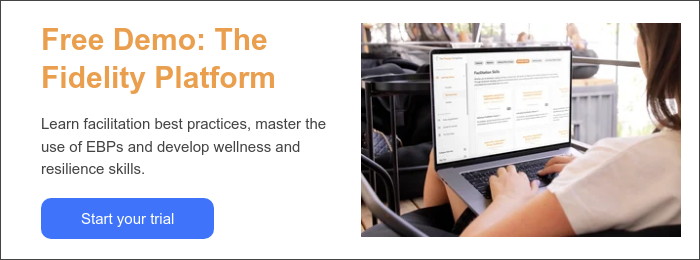Facilitating mindfulness with guided meditations

At a basic level, mindfulness can be defined as paying attention to one’s thoughts, feelings and body with curiosity and without judgment. Mindfulness-based stress reduction therapy (MBSR) was developed by Jon Kabat-Zinn and has grown significantly in the decades since. MBSR has evolved as a treatment for not only stress, but a variety of mental and physical health related disorders. “[MBSR] employs mindfulness meditation to alleviate suffering associated with physical, psychosomatic and psychiatric disorders”¹.
Practicing mindfulness has been shown to increase self-esteem and help participants manage challenging feelings like anxiety, depression and anger². Individuals skilled in mindfulness were better able to detach from difficult emotions — meaning they could recognize and label the emotion without deeply identifying and responding to it. Another study showed that practicing mindfulness correlated with lower levels of aggression and hostility. Studies on the effects of MBSR in prison showed a decrease in hostility, an increase in self-esteem and an increase in emotional self-regulation. It’s also worth noting that increasing self-esteem and emotional self-regulation both can positively contribute to a client’s responsiveness to cognitive-behavioral therapy³.
Guided meditations
From substance use treatment to justice services, implementing mindfulness practices can have significant benefits for participants. So, how do you integrate mindfulness-based interventions into programming?
There are many effective ways to practice mindfulness. Depending on your population and setting, journaling, art, yoga and practicing gratitude can all enhance participant well-being. For a beginner-friendly introduction to mindfulness, we recommend guided meditations.
Guided meditations (or guided practices) can cover topics like breath work, noticing thoughts and feelings, taking a mindfulness walk, progressive muscle relaxation, self-compassion and more. With guided practices, participants are encouraged to notice aspects of their inner experience and to be kind to themselves. Guided mindfulness exercises can be facilitated in individual or group sessions, or they can be self-guided through the use of videos, recordings or printed scripts.
Try a guided meditation for yourself
Below is a five-minute guided meditation for noticing your breath. We invite you to follow along.
Additional recorded meditation videos are available exclusively on our Fidelity Platform.
Guided practice scripts are also built in to The Change Companies’ Interactive Journaling® Facilitator Guides as scripts that make it easy for providers to help participants practice mindfulness.
Key tip
It is important to be aware that practicing mindfulness meditation can lead some participants to feel anxious or overwhelmed. Be aware that practicing mindfulness meditation can lead some participants to feel anxious or overwhelmed. This is common among people who have experienced trauma or are recovering from addiction. Participants may not be comfortable with closing their eyes and that’s okay. Let the group know they can take a relaxed, downward gaze instead or choose a spot in the room to rest their eyes.
Pay attention to participants who show discomfort so you can be sensitive to their experience. Let participants know they can open their eyes if the practice becomes too overwhelming. They may want to take a few deep breaths or pay attention to something else in the room (e.g., colors, sounds or the surface they are resting on). You also might want to recommend trauma programming to participants if it appears they may benefit from more specific help.
Want to learn more about how your population can benefit from mindfulness? Explore this blog on implementing mindfulness practices, check out our evidence-based Daily Mindfulness program or contact our team.
References
³ Bouw, N., Huijbregts, S. C. J., Scholte, E., & Swaab, H. (2019). Mindfulness-Based Stress Reduction in Prison: Experiences of Inmates, Instructors, and Prison Staff. International Journal of Offender Therapy and Comparative Criminology, 63(15-16), 2550-2571. https://doi.org/10.1177/0306624X19856232
Farb, N. A., Anderson, A. K., & Segal, Z. V. (2012). The mindful brain and emotion regulation in mood disorders. Canadian journal of psychiatry. Revue canadienne de psychiatrie, 57(2), 70–77. https://doi.org/10.1177/070674371205700203
Harding-White, M.F., Mojtahedi, D. and Carson, J. (2024), "Group-based mindfulness interventions in prisons: a selective critical review", The Journal of Forensic Practice, Vol. 26 No. 1, pp. 1-17. https://doi.org/10.1108/JFP-10-2022-0054
Heppner WL, Kernis MH, Lakey CE, Campbell WK, Goldman BM, Davis PJ, Cascio EV. Mindfulness as a means of reducing aggressive behavior: dispositional and situational evidence. Aggress Behav. 2008 Sep-Oct;34(5):486-96. https://doi.org/10.1002/ab.20258
Marcus, M. T., & Zgierska, A. (2009). Mindfulness-based therapies for substance use disorders: part 1. Substance abuse, 30(4), 263–265. https://doi.org/10.1080/08897070903250027
Maull, F., Crisp, K. (2018). Can Mindfulness Make Prison a Healthier Place?. In: Jeglic, E., Calkins, C. (eds) New Frontiers in Offender Treatment . Springer, Cham. https://doi.org/10.1007/978-3-030-01030-0_10
¹ Niazi, A. K., & Niazi, S. K. (2011). Mindfulness-based stress reduction: a non-pharmacological approach for chronic illnesses. North American journal of medical sciences, 3(1), 20–23. https://doi.org/10.4297/najms.2011.320
Samuelson, M., Carmody, J., Kabat-Zinn, J., & Bratt, M. A. (2007). Mindfulness-Based Stress Reduction in Massachusetts Correctional Facilities. The Prison Journal, 87(2), 254-268. https://doi.org/10.1177/0032885507303753
Shapero, B. G., Greenberg, J., Pedrelli, P., de Jong, M., & Desbordes, G. (2018). Mindfulness-Based Interventions in Psychiatry. Focus (American Psychiatric Publishing), 16(1), 32–39. https://doi.org/10.1176/appi.focus.20170039
² Wheeler, M.S., Arnkoff, D.B. & Glass, C.R. The Neuroscience of Mindfulness: How Mindfulness Alters the Brain and Facilitates Emotion Regulation. Mindfulness 8, 1471–1487 (2017). https://doi.org/10.1007/s12671-017-0742-x

